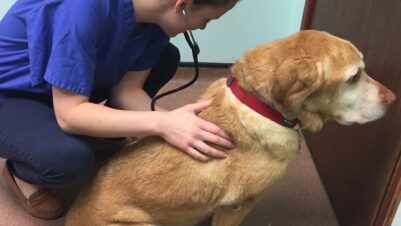
An estimated 23 to 55 percent of the UK dog population are thought to suffer from some form of separation-related behaviour, and separation issues account for 14 to 40 percent of all behaviour referrals (de Assis et al., 2020).
The term “separation anxiety” is most commonly used to describe a wide range of separation-related behaviours stemming from a number of causes, such as anxiety, frustration and fear. The most common presentation of separation anxiety is a problem of isolation distress, and cases of true clinical separation anxiety are few and far between. However, for ease, we shall use the term “separation anxiety” going forward.
For a dog displaying isolation distress, the presence of a human is sufficient, and it does not have to be the primary caregiver
The bond formed between dogs and their human owners is often described as a “true attachment” – even in the absence of separation-related behaviour problems, the emotional attachment between adult dogs and their owners has been found to be similar to those displayed by human adults and their children (Topál et al., 1998). For a dog displaying isolation distress, the presence of a human is sufficient, and it does not have to be the primary caregiver.
What are the signs of separation anxiety in dogs?
Common symptoms of separation anxiety include:
- Excessive vocalisation (howling/barking/crying)
- Destruction of property
- Escape attempts
- Toileting/soiling
- Chewing
- Lack of interest in food/toys
Hypothetically, a separation-related behaviour could be anything the dog does with greater intensity or to a more problematic level when the owner isn’t around; however, the above signs are the most commonly seen (Naismith, 2019).
Many rule-outs must be considered when diagnosing separation anxiety because, in many cases, other factors contribute to the behaviours. Sometimes a dog may only bark when home alone but is actually barking at people walking past the window. Previously, the dog may have done this when the owners were present, but the dog has now been taught to manage this behaviour in the presence of the owners. Another example may be soiling, which could be due to incomplete toilet training rather than separation problems.

Why do dogs develop separation anxiety?
Separation anxiety develops from a natural evolutionary mechanism present in all social animals, which exists to protect young individuals from the actual dangers of being left alone or moving away from an environment that provides safety for the animal.
“Fear relates to a known or understood threat, whereas anxiety follows from an unknown, expected or poorly defined threat”
APA, 2013
But there are many factors that may contribute to a dog developing separation anxiety later in life. For some, there is an obvious cause, such as a previous bad experience, while for others, the initiating factor is not always clear. Influence may be genetic (Sarviaho et al., 2020) or from early-life experiences and environment, maternal stress, maternal behaviour or, as previously mentioned, a bad experience resulting in a fear of being left alone.
Separation anxiety tends to worsen continually. Sherman and Mills (2008) state that: “treatment is often delayed until problematic responses are extreme, such as occurs with panic reactions or reactions to multiple stimuli. Animals with these problems may be perfectly normal at other times and may not be described temperamentally as fearful.”
Common separation anxiety myths
- Some breeds are more prone to separation anxiety: currently, research has not found separation anxiety to be more prevalent in any particular breeds (Sherman and Mills, 2008)
- A dog will grow out of separation anxiety: by regularly leaving a dog suffering from separation anxiety alone, the most likely outcome will be an exacerbation of the problem, and the dog will continue to suffer (Wright and Nesselrote, 1987; McCrave, 1991)
- Leaving a dog to “cry” it out will fix the problem: the more a dog is left to “cry” when frightened, the more the panic escalates, which can make the problem worse in the long run
- The dog can be left alone while working on the problem: the dog must not experience any “negative” home alone time during training for separation anxiety. Much like other behaviour work, the dog must always remain below the threshold during the training process
- Getting another dog will help: multiple research papers show that in most cases, getting another dog does not improve separation-related behaviours, as the anxiety stems from isolation from human company (Lund and Jorgensen, 1999; Parthasarathy and Crowell-Davis, 2006; Ballantyne, 2018)
- Food toys/leaving the radio on/leaving a t-shirt will help: dogs are an intelligent enough species to understand that the radio or item of clothing is not comparable to human companionship. Food toys rarely help as most dogs with separation-related behaviours are too stressed to eat or will panic as soon as the activity is finished. These items can also become pre-departure cues, signalling that the caregiver is about to leave, which can increase anxiety
- The owner must be the pack leader: this is extremely outdated advice for any behaviour problem, but advice that is still frequently referred to. Thanks to much research by Mech and others, it is now known that this school of thought is incorrect (Mech, 1970)
- Crating your dog will help the problem: the majorityof dogs with separation anxiety or isolation distress will also suffer from confinement anxiety, therefore crating them often makes the problem worse (DeMartini-Price, 2020)
- Increasing exercise will fix the problem: while appropriate exercise is good for dogs, being tired from a walk or run in the park will not fix the problem
What advice should be given to a client whose dog is displaying signs of a separation-related behaviour problem?
- Carry out a full health check (as behavioural indicators can often be linked to clinical conditions)
- Suspend all absences for longer than the dog is able to cope with at the time (for many clients, this might mean suspending absences completely for the time being)
- Increase space for the dog if it is not dangerous to do
- Recommend contacting a registered clinical animal or veterinary behaviourist
A programme of systematic desensitisation, sometimes coupled with pharmacological intervention, provides the best chance of resolving separation-related behaviours. Resolution of separation-related problems is usually a long process, but the prognosis for treatment is usually good.







